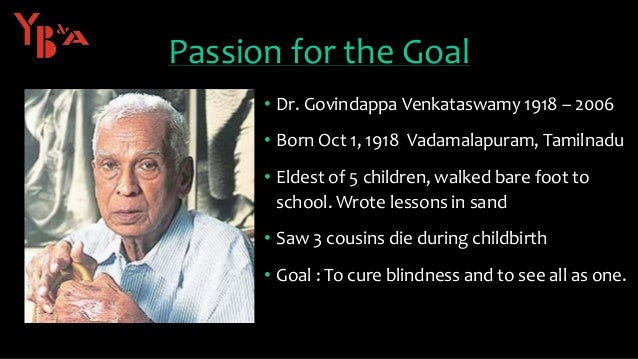Dr. Govindappa Venkataswamy's 100th Birthday Anniversary
Govindappa Venkataswamy (1 October 1918 – 7 July 2006) was an Indian ophthalmologist who dedicated his life to eliminate needless blindness. He was the founder and former chairman of Aravind Eye Hospitals, the largest provider of eye care in the world.[1]He is best known for developing a high quality, high volume, low-cost service delivery model that has restored sight to millions of people. Since inception, Aravind Eye Care System (a registered non-profit organisation) has seen over 55 million patients, and performed over 6.8 million surgeries.[2] Over 50% of the organisation's patients pay either nothing or highly subsidised rates. Revenues from patients who choose to pay subsidise care for the rest. Aravind regularly runs a surplus primarily through earned revenue from patient services, and does not solicit donations for its core activities.[3] Its scale and self-sustainability prompted a 1993 Harvard Business Case Study on the Aravind model.[4]

Venkataswamy (known as Dr V) was permanently crippled by rheumatoid arthritis at age 30. He trained as an ophthalmologist, and personally performed over 100,000 eye surgeries.[5] As a government servant he helped develop and pioneer the concept of eye camps[5] and received a Padma Shri from the Government of India in 1973.[6]. in 1976, at the age of 58, he retired from government service and founded Aravind in Madurai, Tamil Nadu along with his four siblings and their spouses. The hospital began as an 11-bed clinic that operated out of a rented house. Today, the Aravind Eye Care System includes a network of 7 tertiary care eye hospitals, 6 secondary eye care centres, and 70 primary eye care centres in South India.
In 1992, Dr V and partners of Aravind founded Aurolab, an internationally certified manufacturing facility that brought the price of the intraocular lens down to one-tenth of international prices, making it affordable for developing countries.[7] Today, Aurolab manufactures ophthalmic pharmaceuticals, instruments and equipment, in addition to intraocular lenses, and exports to 120 countries worldwide. In 1996, under Dr V's leadership, the Lions Aravind Institute for Community Ophthalmology (LAICO) was founded. LAICO is a training and consulting institute that has helped replicate the Aravind model in 347 hospitals across India and 30 other developing countries.[8]
Over his lifetime, Dr V built a wide network of partnerships with institutions in India and abroad that continue to work with his organisation. [9]Over 35 members of his extended family, including more than 25 eye surgeons across three generations of his family, work at Aravind. Dr V was a disciple of spiritual teachers Sri Aurobindo and Mirra Alfassa (The Mother). In his words: “Aravind Hospital aims at bringing higher consciousness to transform mind and body and soul of people. It is not a mechanical structure repairing eyes. It has a deeper purpose. It is not about buildings, equipment, money or material things, but a matter of consciousness.”[10] His life work is documented in a film [11]and book, both titled Infinite Vision
Dr V & the Aravind Model
Dr V pioneered mobile eye camps with the government and later implemented this practice at Aravind. Teams of doctors and nurses from Aravind regularly visit rural villages where they conduct 'eye camps' those screen patients for vision impairments. Those requiring glasses receive them on site. Patients requiring surgery are bused back to an Aravind hospital, where they receive surgery, room and board, return transport and a follow up visit at no charge. Each year Aravind hosts over 2,100 camps, averaging 40 camps every week with 500 community partners.[12]
Dr V introduced a tiered pricing system at Aravind. There are no income assessments or eligibility criteria for free or subsidised treatment. Patients decide whether they would like to access free, subsidised or paid services. Within this system, a cataract operation ranges from free to a little under USD $830 (~ Rs. 53,700) based on the accommodations associated with the surgery and the type of lens implanted.[13] Patients can self-select services and room type based on preference and ability to pay, without compromising clinical outcomes. In practice, one patient who pays, subsidises the no-frills surgeries and pre- and post-operative care of two non-paying patients.
Nurses, known within the Aravind system as Mid-Level Ophthalmic Personnel (MLOP), are trained extensively in discrete skills, and specialise in different areas of the hospital work flow, including administrative work, diagnostics, nursing and counseling. [14]The MLOPs are primarily women who are high-school graduates recruited from surrounding villages. In the operating room each surgeon is assisted by four MLOPs. With stream-lined processes Aravind averages 2,000 surgeries per doctor per year compared to a national average of 400.[15] Tina Rosenberg for the New York Times writes, "Aravind can practice compassion successfully because it is run like a McDonald’s with assembly-line efficiency, strict quality norms, brand recognition, standardization, consistency, ruthless cost control and above all, volume. Each year, Aravind does 60 percent as many eye surgeries as the United Kingdom’s National Health System, at one one-thousandth of the cost.
Since 1993 Harvard Business School has distributed more than 150,000 copies of 'In Service for Sight' (their original case study on the Aravind model) to the top twenty business schools in the United States.
for details article visit: https://en.wikipedia.org/wiki/Govindappa_Venkataswamy





No comments